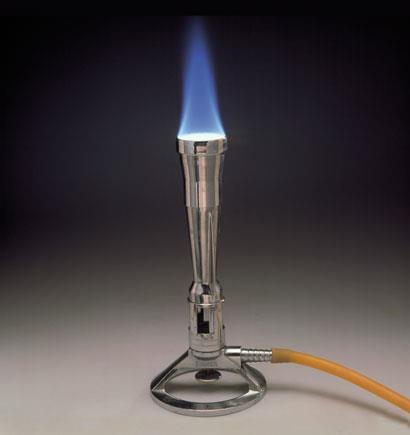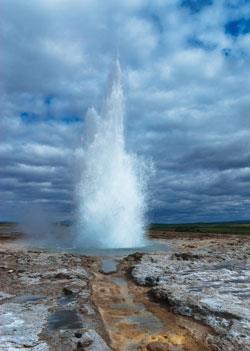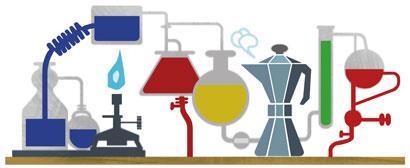Robert Bunsen's explosive career left an indelible impact - both in advancement of knowledge and the ubiquitous gas burner. Mike Sutton follows in his footsteps
Robert Bunsen’s explosive career left an indelible impact - both in advancement of knowledge and the ubiquitous gas burner. Mike Sutton follows in his footsteps
When Iceland’s Mount Hekla erupted in 1845 there were no airliners for it to ground. However, like the ash clouds spewed out of Eyjafjallaj?kull in 2010 and Gr?msv?tn this year, the event aroused considerable scientific interest. The Danish government commissioned an expedition in 1846 which included Robert Bunsen, a German chemist whose experience analysing blast-furnace gases qualified him for the task.

Having collected samples inside the still-smouldering crater, he lowered thermometers into a geyser shortly before it was due to expel a massive jet of steam. This audacity was typical of the man - danger never kept him away from a promising line of research. And despite many years of investigating toxic and explosive substances, he survived into his late 80s.

Born in G?ttingen on 31 March 1811, Robert Wilhelm Eberhard Bunsen was the fourth and youngest son of Christian Bunsen, professor of philology at G?ttingen University. In later life, Robert recalled that his youthful stubbornness had been a severe trial for his parents and teachers - only his beloved mother had been able to keep him in check. But there was no doubting his intelligence, and he completed his doctorate at G?ttingen aged 19. After pursuing further studies in Paris, Berlin and Vienna, he returned home in 1834 to become a privatdozent (a licensed but unsalaried university tutor) in chemistry.
From 1836 Bunsen taught at the polytechnic school in Kassel, moving on in 1838 to Marburg University, where he became a full professor in 1842. 10 years later he succeeded Leopold Gmelin as chair of chemistry at the University of Heidelberg, and remained there until retiring in 1889. During more than half a century of teaching and research he made valuable contributions to several areas of chemistry. Many of his former students also had distinguished careers.
Stinking poisons
Bunsen’s first significant research (published in 1834) was on the salts of arsenious acid. It produced the important discovery that freshly precipitated ferric hydroxide was an effective antidote to arsenic poisoning. In 1835-6, he isolated and analysed several previously unknown (and highly toxic) cyanide compounds. And between 1837 and 1843 he investigated a family of organo-arsenic compounds which were both poisonous and inflammable.
These were the cacodyl compounds - a name derived from the Greek word for ’stinking’ - and their exact composition was uncertain until Bunsen tackled them. His investigations demonstrated that they were all derivatives of one parent compound, which we now know as tetramethyldiarsine, (CH3)2As-As(CH3)2.
Bunsen described their impact vividly: ’The cacodyl compounds appear to exert a specific action on the nervous system. It is remarkable that when one is exposed to the smell of these compounds the tongue becomes covered with a black coating, even when no further evil effects are noticeable.’5
Further evil effects did eventually follow. In 1843 a sample of cacodyl cyanide exploded in Bunsen’s laboratory, permanently blinding his right eye and poisoning him so severely that his life hung in the balance. But he returned to the bench and successfully completed the investigation.
Fumes and volcanoes

An industrial project which occupied Bunsen intermittently from 1838 to 1846 exposed him to further risks. While analysing blast furnace exhaust gases - which included carbon monoxide and cyanogen (N? C-C? N) - he lost consciousness and was dragged to safety by a colleague. His researches showed that German charcoal-burning furnaces wasted almost 50 per cent of their fuel, while a later study of British coke-fired furnaces (in collaboration with the scientist and politician Lyon Playfair) indicated a wastage rate of 80 per cent. Ironmasters were reluctant to adopt Bunsen’s suggestion that recycled exhaust gases might be used as a fuel supplement, but they eventually recognised its advantages.
While pursuing this research, Bunsen greatly improved existing techniques of gas analysis, making him an ideal candidate for the 1846 volcano expedition. Letters to his mother from Iceland give a vivid account of his adventures there: ’The scenery in this far north is full of desolation but is wonderfully beautiful, and I shall never regret that I have seen it, even though it cost me the unbelievable privations and exertions to which we are subjected here.’3
After descending through clouds of steam and fumes into Hekla’s crater - which had been in full eruption only three months previously - Bunsen collected hundreds of samples for analysis. When he lowered his thermometer down the shaft of a quiescent geyser, it revealed that the pressure at lower levels was keeping the water liquid at a temperature well above its normal boiling point.
However, the water at the bottom of a geyser is in direct contact with extremely hot rocks, and sooner or later it boils, despite the intense pressure. The resulting steam pushes the superheated water above it up the shaft, causing it to boil explosively as the pressure on it falls. These explosions usually (though not always) occur at predictable intervals - on one occasion Bunsen’s geyser blasted a column of steam 50m into the air moments after he had retreated from it.
Elemental electricity
Bunsen also made significant improvements to electrical cells. In 1841 he replaced the Grove cell’s platinum cathode with a cheaper one made from specially processed carbon, and used a battery of 44 such cells to power a brilliant arc light. To measure its intensity accurately, he invented a simple but effective instrument - the grease-spot photometer - which was widely used for many years.
From 1852 Bunsen employed this battery to prepare pure samples of reactive metals - including strontium, barium, aluminium, and several rare earths - by electrolysing their molten salts. He then determined their specific heats using a sensitive calorimeter of his own design, which measured volume changes in a mixture of ice and water kept at a constant temperature of 0?C.
Having obtained reliable specific heat values, Bunsen was able to estimate the atomic weights of these elements, using the law proposed by French chemists Pierre Dulong and Alexis Petit. This helped his former pupils Lothar Meyer and Dmitri Mendeleev to develop their periodic classification systems for the elements - a process which they both began by arranging the elements in ascending order of atomic weight.
Bunsen was also the first to prepare pure magnesium in quantity, and in 1859 he recommended burning it as a light source for photography. Commercial portrait photographers soon took up his suggestion and by the end of the century flash powder was a standard ingredient of photo-journalism. Self-contained and disposable magnesium lights were not available until the 1920s, but Bunsen can be legitimately described as the grandfather of the flash-bulb. However, photographic work formed only a small part of his photochemical investigations during the 1850s.
Together with his former student Henry Roscoe, Bunsen made an extended study of the photo-catalysed combination of chlorine with hydrogen - a reaction which John Draper had already struggled with in New York. Bunsen and Roscoe found that the rate of reaction was proportional to the intensity of illumination, but only after an initial ’induction period’. They were unable to explain this delay, but later studies (by David Chapman and others) showed that it was caused by traces of organic impurities combining with the photo-activated chlorine.
The burner and spectroscopy
Bunsen’s best known invention (although the credit for it should be shared with others) emerged in 1855, as his new laboratory was being supplied with piped coal-gas. Wanting a heat source that was more powerful than a spirit-lamp, but more adaptable than a charcoal furnace, he designed a novel gas burner in collaboration with his technician, Peter Desaga. Other workers, including Aim? Argand and Michael Faraday, had already experimented with gas burners, but Bunsen’s version rapidly became the standard model.

The burner proved particularly useful for flame tests. However, in 1859 Bunsen’s friend, the physicist Gustav Kirchhoff, alerted him to the possibility of improving this analytical technique by employing a prism. The origins of the spectroscope can be traced back well before that date, and many previous investigators - including William Wollaston, Joseph von Fraunhofer and Sir John Herschel - contributed to its development. But Bunsen and Kirchhoff systematised its use, and then publicised its potential by discovering two new elements, rubidium and caesium.
Other mid-19th century scientists - among them George Stokes and Anders ?ngstr?m - argued that an element’s spectrum might yield information about its atomic structure. Their hopes were reasonable, but premature - another half-century passed before Niels Bohr began relating spectral lines to sub-atomic energy exchanges. Meanwhile, Kirchoff and Bunsen abstained from theoretical speculation on this topic, as they did on most others.
In Kirchhoff’s case, this restraint was grounded in his rigorously positivistic philosophy of science. But for Bunsen, it seems, theorising was simply a distraction from the ongoing adventure of experimentation. He was happiest when making things happen in his laboratory, and preferred to leave the hunt for hypotheses about hidden causes to thinkers whose inclinations lay in that direction.
Flashes and bangs
In his later years Bunsen continued working on dangerous substances, including gunpowder. He studied several explosive gas reactions, and applied the principle of the stroboscope in attempts to track their progress, but met with only limited success. (Even after the development of high-speed photography, this area of research remained problematic for decades). And in 1868, while working on the platinum group of metals, he survived yet another laboratory explosion.
The Imperial Russian mint at St Petersburg had a technique for separating pure platinum from its ore, but palladium, iridium, ruthenium and rhodium remained mingled in the residue. Bunsen sought ways of extracting them, and along the way he developed a more effective filter pump for washing precipitates, which was soon adopted by other chemists.
But while he was handling a mixture of iridium and rhodium in the form of a finely divided powder, it ignited spontaneously. He informed Roscoe: ’My left hand . saved my eyes, as my face and eyes were only superficially burnt by the flames which penetrated through my fingers. My eyes are, with the exception of singed eyebrows and eyelashes, unhurt, and so the explosion will luckily leave behind no serious traces.’5
Undeterred by this mishap, Bunsen found ways of recovering all the metals in pure form, and continued doing original (though less eventful) research on various other substances for several years afterwards. He retired from teaching in 1889, but remained interested in the progress of chemistry until shortly before his death in 1899.
Investigator, teacher and friend
A career crammed with discoveries earned him numerous honours, including the Royal Society’s Copley and Davy Medals. But despite the intensity of his research effort, he never neglected his students. One of the many who flourished under Bunsen’s guidance declared that: ’As an investigator he was great, as a teacher he was greater, as a man and a friend he was greatest.’4
Less distinguished pupils also had reason to be grateful to him. At the end of every term, Heidelberg’s lecturers had to sign attendance certificates for their students. When one persistent absentee sought Bunsen’s endorsement, the professor remarked that he had not noticed him in the lecture hall. The delinquent replied that this was because he always sat behind a pillar. Bunsen sighed: ’Ah.there sit so many’, but signed his certificate anyway.
About Bunsen’s personal life, there is little to be said. He rose before dawn, worked very long hours, and then dined frugally at a local inn. His only recreation was an occasional walk in the country. When asked why he had never married, he replied that it was because he spent too much time in the laboratory. However, it may be that frequent exposure to unpleasant substances also helped to preserve his bachelorhood. After meeting him, Agnes Fischer (the wife of German chemist Emil Fischer) said: ’First, I would like to wash Bunsen, and then I would like to kiss him because he is such a charming man.’6

This year, on the 200th anniversary of his birth, Google reminded the world of the continuing relevance of Bunsen’s work with a distinctive dynamic logo.7 But a more enduring memorial is the daily acquaintance which millions of science students have with his most famous invention, the burner.
Mike Sutton is a visiting fellow in the department of humanities at Northumbria University, UK
References
1 T Curtius, 'Robert Wilhelm Bunsen', in Great chemists, E Farber (Ed), New York, 1961, 575
2 W B Jensen, J. Chem. Educ., 2005, 82, 518 (DOI: 10.1021/ed082p518)
3 R E Oester and K Freudenberg, J. Chem. Educ., 1941, 18, 253 (DOI: 10.1021/ed018p253)
4 J R Partington, A history of chemistry , vol IV, London 1964, 281
5 H E Roscoe, J. Chem. Soc. Trans., 1901, 77, 513 (DOI: 10.1039/ct9007700513)
6 RSC Library collection, 'Robert Bunsen's 200th Anniversary' (see 'Also of interest' below)
7 Google's Bunsen Doodle logo (see link below)






No comments yet